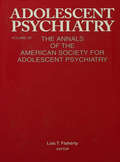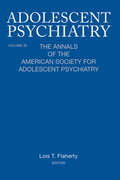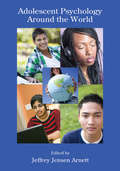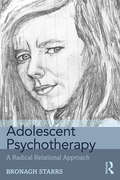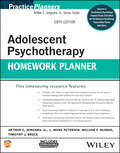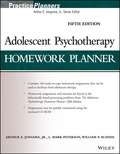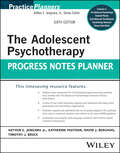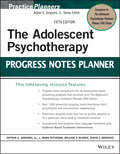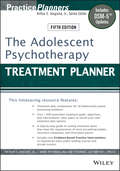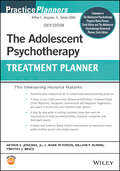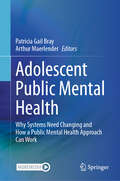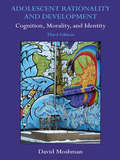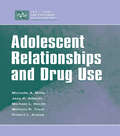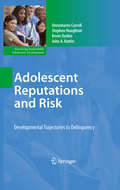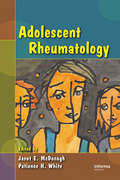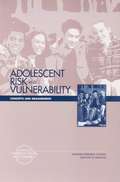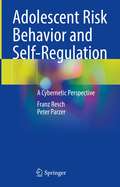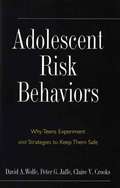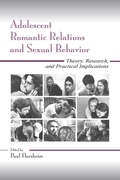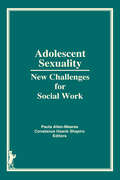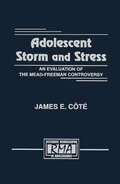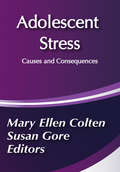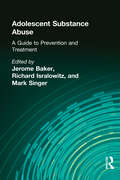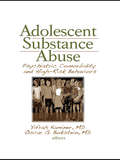- Table View
- List View
Adolescent Psychiatry, V. 29: The Annals of the American Society for Adolescent Psychiatry
by Lois T. FlahertyA special section on adolescent substance abuse highlights Volume 29 of Adolescent Psychiatry. Contributions range from an examination of brain myelination in relation to onset of addictive disorders (Bartzokis) to the screening instruments used to detect substance use disorders (Rosner) to practical aspects of psychiatric assessment and management of substance abusing adolescents (Havivi). Topical studies focus on the changing patterns of use and health risks of the "designer drug" Ecstasy (Grob); the club drugs gamma-hydroxybutyrate and ketamine (Miotto et al.); and adolescent pathological gambling, a behavioral disorder with strikingly addictive features. Taken together, these illuminating essays converge in an appreciation of adolescent substance abuse and addiction in all their biopsychosocial complexity. Elsewhere in Volume 29, contributors review neuroimaging studies in an effort to shed light on adolescent psychiatric disorders (Day et al.); reevaluate the construct of borderline personality disorder as it pertains to adolescence (Becker & Grilo; Paris); and present the encouraging results of a pilot project on the psychodynamic psychotherapy of adolescents with panic disorder (Milrod et al.). A case series on the treatment of hospitalized adolescents who deliberately ingest foreign objects (Petti et al.) and a case study of the cross-cultural issues that arose in the therapy of an Asian American adolescent (Shen et al.) enlarge the clinical and cultural scope of the volume. True to the legacy of previous volumes in the series, Volume 29 of Adolescent Psychiatry brings within its purview all the elements of a multidimensional grasp of adolescent development, psychopathology, and treatment. Neuroscientific findings, empirical clinical studies, case series, and descriptions of clinical approaches all take their place in this illuminating and richly textured collection.
Adolescent Psychiatry, V. 30: The Annals of the American Society for Adolescent Psychiatry
by Lois T. FlahertyThe period of adolescence can be a time of great creativity, as new intellectual capacities emerge, and as the individual adolescent attempts to make sense out of inner and outer experience. Volume 30 of Adolescent Psychiatry addresses the ways in which adolescent experience is transmuted into creative artistic production, as well as focuses on the relationship between creativity and psychopathology, and treatment for troubled adolescents. With the links between adolescence and creativity in mind, the volume opens with an in-depth examination of a young boy’s creation of his own story of Polyphemus. This is followed by a fresh look at the adolescent influences behind Austrian Symbolist painter Gustav Klimt. The next ten chapters comprise a special section devoted to creative solutions to some of the most challenging facing adolescent psychiatry. Here, numerous relevant studies are presented and conclusions drawn, as a whole addressing topics such as: an innovative residential treatment program for gifted adolescents who have failed academically and rejected previous attempts at treatment; motivational interviewing, a technique employed in the effort to find common ground between the therapist and patient; the importance of understanding adolescent sexuality and how to approach the topic with patients in an appropriate manner; and a discussion of the registration, commitment, and assessment of juvenile sex offenders. A final section investigates problematic examples of reactive attachment disorder, as well as treatment-refractory adolescent schizophrenia – when the medication doesn’t work. Volume 30 of Adolescent Psychiatry continues the wide-ranging scholarship and analytic sensibility that has been the hallmark of the series. Literary and artistic criticism reside comfortably between empirical research and case studies, all working together to broaden the horizon of research and application of psychiatric technique and theory for adolescence.
Adolescent Psychology Around the World
by Jeffrey Jensen ArnettThis book paints a portrait of adolescent psychology in 4 major regions: Africa/the Middle East, Asia, the Americas, and Europe. Featuring 24 revised and updated chapters from the International Encyclopedia of Adolescence (2007), readers are introduced to the way the majority of the world’s adolescents actually live. Most contributors are indigenous to the country they review. As a whole the book paints an engaging panorama of adolescent life around the world, broadening students’ cultural perspective. All chapters follow the same template to make it easier to compare topics across countries: Background (including demographics, ethnic diversity, and political system), Period of Adolescence, Beliefs, Gender, the Self, Family Relationships, Friends and Peers/Youth Culture, Love and Sexuality, Health Risk Behavior, Education, Work, Media, Politics and Military, and Unique Issues. Each chapter contains a map and photos and a list of references and suggested readings. The introductory chapter explains why the countries were selected and introduces the book’s common themes. The section on Africa and the Middle East introduces students to teen life in Cameroon, one of the few places left where adolescents go through formal puberty rituals. In addition, readers learn about adolescent life in Ethiopia, Israel, Morocco, Nigeria, and Sudan. Next we travel to Asia -- China, India, Indonesia, and the Philippines. Here readers see how economic growth in India and China is creating opportunities for young people. In The Americas, readers are introduced to life in Argentina, Canada, Chile, Mexico, Peru, and the United States. The book concludes with adolescent life in Europe including the Czech Republic, France, Germany, Italy, the Netherlands, Russia, Sweden, and the UK. Intended for courses in adolescent psychology, lifespan development, and/or cultural (cross-cultural) psychology taught in departments of psychology, human development and family studies, sociology, and education, this book will also appeal to researchers and clinicians who study or work with adolescents.
Adolescent Psychotherapy: A Radical Relational Approach
by Bronagh StarrsCounsellors and psychotherapists are faced with ever-increasing complexity in their work with adolescents. In this book, Bronagh Starrs offers an understanding of developmental and therapeutic process from a relational-phenomenological Gestalt perspective. Starrs shows how the adolescent’s presenting symptom issues are statements of compromised lifespace integrity and demonstrates therapeutic sensibility to the adolescent’s first-person experience. Throughout the book, the clinician is offered extensive relational and creative strategies to support integrity repair for the adolescent. The developmental impact of various lifespace contexts are discussed, including parental separation, complex family configuration, grief, adoption, and emerging sexual orientation and gender experience. Therapeutic responses to common creative adjustments are explored including anxiety, school refusal, depression, self-harm, suicide, eating disorders, alcohol and drug use, and sexual trauma. Adolescent Psychotherapy: A Radical Relational Approach will help counsellors and psychotherapists to develop deeper levels of competency in their work as adolescent psychotherapists, as they navigate the complex and fascinating experience of therapy with teenagers. This exceptional contribution is highly suitable for both experienced practitioners and students of counselling and psychotherapy.
Adolescent Psychotherapy Homework Planner (PracticePlanners)
by Arthur E. Jongsma Jr. L. Mark Peterson William P. McInnis Timothy J. BruceEvidence-based and effective clinical homework for adolescent clients and their caregivers In the newly updated sixth edition of The Adolescent Psychotherapy Homework Planner, a team of distinguished practitioners delivers a time-saving and hands-on practice tool designed to offer clients valuable homework assignments that will further their treatment goals for a wide variety of presenting problems. The Homework Planner addresses common and less-common disorders—including anxiety, depression, substance use, eating, and panic—allowing the client to work between sessions on issues that are the focus of therapy. This book provides evidence-based homework assignments that track the psychotherapeutic interventions suggested by the fifth edition of The Adolescent Psychotherapy Treatment Planner. They are easily photocopied, and a digital version is provided online for the therapist who would prefer to access them with a word processor. The Homework Planner also offers: Cross-referenced lists of suggested presenting problems for which each assignment may be appropriate (beyond its primary designation) Several brand-new assignments, as well as adapted assignments that have been shortened or modified to make them more adolescent-client-friendly Homework assignments for the parents of adolescents in treatment, assignments for the adolescents themselves, and assignments for parents and adolescents to complete togetherAn essential and practical tool for therapists and practitioners treating adolescents, The Adolescent Psychotherapy Homework Planner, Sixth Edition will benefit social workers, psychologists, psychiatrists, and other clinicians seeking efficient and effective homework tools for their clients.
Adolescent Psychotherapy Homework Planner
by L. Mark Peterson Arthur E. Jongsma Jr. William P. McinnisNew and updated assignments and exercises to meet the changing needs of mental health professionalsThe Adolescent Psychotherapy Homework Planner, Fifth Edition provides you with an array of ready-to-use, between-session assignments designed to fit virtually every therapeutic mode. This easy-to-use sourcebook features:146 ready-to-copy exercises covering the most common issues encountered by adolescent clients including such problems as blended families, substance use, and eating disordersA quick-reference format--the interactive assignments are grouped by behavioral problems including academic underachievement, anger control problems, depression, social anxiety, and sexual abuseExpert guidance on how and when to make the most efficient use of the exercisesAssignments cross-referenced to The Adolescent Psychotherapy Treatment Planner, Fifth Edition--so you can quickly identify the right exercises for a given situation or problemA CD-ROM contains all the exercises in a word-processing format--allowing you to customize them to suit your and your clients' unique styles and needs
The Adolescent Psychotherapy Progress Notes Planner (PracticePlanners)
by Arthur E. Jongsma Jr. Katy Pastoor David J. Berghuis Timothy J. BruceSave hours of time-consuming paperwork with the bestselling planning system for mental health professionals The Adolescent Psychotherapy Progress Notes Planner, Sixth Edition, provides more than 1,000 complete prewritten session and patient descriptions for each behvioral problem in The Adolescent Psychotherapy Treatment Planner, Sixth Edition. Each customizable note can be quickly adapted to fit the needs of particular client or treatment situation. An indispensable resource for psychologists, therapists, counselors, social workers, psychiatrists, and other mental health professionals working with adolescent clients, The Adolescent Psychotherapy Progresss Notes Planner, Sixth Edition: Provides over 1,000 prewritten progress notes describing client presentation and interventions implemented Covers a range of treatment options that correspond with the behavioral problems and current DSM-TR diagnostic categories in the corresponding Adolesecent Psychotherapy Treatment Planner Incorporates DSM-5 TR specifiers and progress notes language consistent with evidence-based treatment interventions Addresses more than 35 behaviorally based presenting problems, including social anxiety, suicidal ideation, conduct disorder, chemical dependence, bipolar disorder, low self-esteem, ADHD, eating disorders, and unipolar depression Includes sample progress notes that satisfy the requirements of most third-party payors and accrediting agencies, including JCOA, CARF, and NCQA Features new and updated information on the role of evidence-based practice in progress notes writing and the status of progress notes under HIPAA
The Adolescent Psychotherapy Progress Notes Planner
by L. Mark Peterson Arthur E. Jongsma Jr. William P. Mcinnis David J. BerghuisSave hours of time-consuming paperwork with the bestselling therapist's resourceThe Adolescent Psychotherapy Progress Notes Planner, Fifth Edition, contains more than 1,000 complete prewritten session and patient descriptions for each behavioral problem in The Adolescent Psychotherapy Treatment Planner, Fifth Edition. The prewritten notes can be easily and quickly adapted to fit a particular client need or treatment situation. The Fifth Edition:Provides an array of treatment approaches that correspond with the behavioral problems and new DSM-5 diagnostic categories in the corresponding companion Treatment Planner.Organizes treatment for over 30 main presenting problems, including conduct disorder, chemical dependence, low self-esteem, suicidal ideation, ADHD, sexual acting out, and eating disorders.Provides over 1,000 prewritten progress notes summarizing patient presentation and treatment delivered.Offers sample progress notes that conform to the requirements of most third-party payors and accrediting agencies, including The Joint Commission, COA, CARF, and NCQA.Saves clinicians hours of time-consuming paperwork, yet offers the freedom to develop customized progress notes.Presents new and update information on the role of evidence-based practice in progress notes writing and the special status of progress notes under HIPAA.
The Adolescent Psychotherapy Treatment Planner: Includes DSM-5 Updates
by Arthur E. Jongsma Jr. L. Mark Peterson Timothy J. Bruce William P. McinnisThe Adolescent Psychotherapy Treatment Planner, Fifth Edition provides all the elements necessary to quickly and easily develop formal treatment plans that satisfy the demands of HMOs, managed care companies, third-party payors, and state and federal agencies.<P><P> * New edition features empirically supported, evidence-based treatment interventions including conduct disorder, substance use, low self-esteem, suicidal ideation, ADHD, and eating disorders<P> * Organized around 36 behaviorally based presenting problems, including peer/sibling conflict, school violence, sexual abuse, and others<P> * Over 1,000 prewritten treatment goals, objectives, and interventions—plus space to record your own treatment plan options<P> * Easy-to-use reference format helps locate treatment plan components by behavioral problem<P> * Includes a sample treatment plan that conforms to the requirements of most third-party payors and accrediting agencies including CARF, The Joint Commission (TJC), COA, and the NCQA
The Adolescent Psychotherapy Treatment Planner (PracticePlanners)
by Arthur E. Jongsma Jr. L. Mark Peterson William P. McInnis Timothy J. BruceQuickly and efficiently create treatment plans for adolescents in a variety of treatment environments The newly revised sixth edition of the Adolescent Psychotherapy Treatment Planner delivers an essential resource for mental health practitioners seeking to create effective, high-quality treatment plans that satisfy the needs of most third-party payers and state and federal review agencies. This book clarifies, simplifies, and accelerates the treatment planning process for adolescents so you can spend less time on paperwork and more time treating your clients. This latest edition includes comprehensive and up-to-date revisions on treating the victims and perpetrators of bullying and aggression, gender dysphoria, loneliness, opioid use, and sleep disorders. It includes new evidence-based objectives and interventions, as well as an expanded and updated professional references appendix. You'll also find: A new appendix presenting location and availability information in an alphabetical index of objective assessment instruments and structured clinical interviews A consistent focus throughout the book on evidence-based practices and treatments consistent with practice guideline recommendations Ranges of treatment options consistent with the best available research and those reflecting common clinical practices of experienced clinicians An essential treatment planning handbook for clinicians treating adolescents in a variety of settings, the sixth edition of the Adolescent Psychotherapy Treatment Planner is the key to quickly and efficiently creating individually tailored, evidence-based, and effective treatment plans for adolescent clients.
Adolescent Public Mental Health: Why Systems Need Changing and How a Public Mental Health Approach Can Work
by Patricia Gail Bray Arthur MaerlenderThis book presents an innovative public mental health model addressing the global crisis of declining mental health among adolescents. Despite the scholarly and public media attention given to post-pandemic adolescent mental health, few published sources present a sustainable, scalable and multisector collaborative solution that includes attention to the social determinants of health, equity, and prevention, together with mental health literacy education and early intervention. This book takes a public health approach to address this need and is inspired by the authors' experience creating and implementing change in adolescent mental health systems. While prevention, together with diagnosis and treatment, are the most effective ways to address mental illness, a systems-level approach has only recently appeared in the applied mental health scientific literature. Unlike cardiovascular disease and cancer, mental health promotion and mental illness prevention have been slow to gain traction in the U.S. However, leading professional associations are beginning to acknowledge the value of a public health approach to adolescent mental health and the need to support public health and mental health intersectoral policies. The concepts presented in this volume draw on three primary systems: public health, mental health and education. The authors present 24 recommendations that are relevant for scholars, practitioners and leaders involved in adolescent mental health. Among the topics covered: U.S. and global adolescent mental health, public health, and school mental health Why a systems change is needed in adolescent mental health How to implement an adolescent public mental health model Taking action with systems change Adolescent Public Mental Health is essential reading for professionals in mental health, public health, social work, and medicine who are interested in moving to a more integrative, multisectoral approach to adolescent mental health. Educators and academic institutions who teach our future leaders will benefit from understanding the new model, which can be seamlessly included in secondary school education. Clinicians, practitioners, school principals and superintendents can adopt the model and collaborative processes, described in the demonstration project, to respond to the mental health challenges they encounter every day.
Adolescent Rationality and Development: Cognition, Morality, and Identity, Third Edition
by David MoshmanFrequently cited in scholarly books and journals and praised by students, this book focuses on developmental changes and processes in adolescence rather than on the details and problems of daily life. Major developmental changes associated with adolescence are identified. Noted for its exceptionally strong coverage of cognitive, moral, and social development, this brief, inexpensive book can be used independently or as a supplement to other texts on adolescence. Highlights of the new edition include: expanded coverage of thinking and reasoning. a new chapter on metacognition and epistemic cognition. expanded coverage of controversies concerning the foundations of morality. a new chapter on moral principles and perspective taking. a new chapter on the relation of personal and social identity. a new chapter addressing current controversies concerning the rationality, maturity, and brains of adolescents. more detail on key studies and methodologies and boldfaced key terms and a glossary to highlight and clarify key concepts. Rather than try to cover everything about adolescence at an elementary level, this book presents and builds on the core issues in the scholarly literature, thus encouraging deeper levels of understanding. The book opens with an introduction to the concepts of adolescence, rationality, and development and then explores the three foundational literatures of adolescent development - cognitive development, moral development, and identity formation. The book concludes with a more general account of rationality and development in adolescence and beyond. Appropriate for advanced undergraduate and graduate courses on adolescence or adolescent development offered by departments of psychology, educational psychology, or human development, this brief text is also an ideal supplement for courses on social and/or moral development, cognitive development, or lifespan development. The book is also appreciated by scholars interested in connections across standard topics and research programs. Prior knowledge of psychology is not assumed.
Adolescent Relationships and Drug Use (LEA's Series on Personal Relationships)
by Michelle A. Miller-Day Janet Alberts Michael L. Hecht Melanie R. Trost Robert L. KrizekAdolescent Relationships and Drug Use explores the communicative and relational features of adolescent drug use. It focuses on peer norms, risk, and protective factors and considers how drugs are offered to adolescents, examining such factors as who makes the offers and how they are resisted, where the offers take place, and what relationship exists between the persons making the offers and the persons receiving them. Unlike other studies of drug resistance, this work examines the communication processes that affect adolescents' ability to effectively resist drug offers. Michelle Miller and her colleagues study how personal qualities, communication skills, and relationships with others affect an individual's ability to resist offers of drugs. This volume provides a detailed analysis of drug resistance in the context of such factors as relationships, types of drugs, family and peer group relationships, personality, and situations. It places drug use and resistance in a living, relational context, and offers the first comprehensive communication and relational approach to drug resistance. The authors argue for the development of a relational and communication competence model of drug resistance, and suggest unique approaches for future drug prevention efforts. In describing the social and relational processes of drug resistance and then linking intervention techniques to the adolescents' relational world, this work makes a major contribution toward understanding drug use among adolescents. It informs relationship, communication, and psychology research, assists drug and health research by presenting new ways of considering the issue, and enlightens drug resistance practice by demonstrating a new approach to prevention. As such, it makes an effective and invaluable contribution to the ongoing efforts to reduce drug use among adolescents.
Adolescent Reputations and Risk: Developmental Trajectories to Delinquency (Advancing Responsible Adolescent Development)
by Annemaree Carroll John A. Hattie Stephen Houghton Kevin DurkinThe news of teenagers and even younger children committing ever more serious and violent crimes continues to shock and baffle. The escalating psychological and social toll of youth crime is being paid by all - from victims to offenders to parents and siblings to teachers and to the community as a whole. "Adolescent Reputations and Risk" looks beyond traditional theories to examine, from a solid empirical basis, the motivation and values that make some young people choose antisocial over positive behavior, resulting in potent new insights and possible solutions to this ongoing problem. Synthesizing 15 years of research with delinquent youth, this volume describes the volatile dynamic of child and adolescent social worlds, emphasizing reputation enhancement and goal-setting as bases underlying deviant behavior. In innovative and accessible terms, "Adolescent Reputations and Risk" addresses delinquency throughout the course of childhood and adolescence, offers the first detailed explanation of delinquency by integrating goal-setting and reputation enhancement theories, provides evidence analyzing deviant trends in goal-setting and reputation enhancement terms among primary and high school students, answers key questions on topics such as impulsivity, drug and inhalant use, early-childhood psychopathy, links between ADHD and aggression, and the psychology of loners and includes current data on interventions for at-risk youth, including family and school methods, cognitive-behavioral therapy, wilderness and boot camp programs, and interactive multimedia strategies. This volume is an essential resource for clinical child, school, and counseling psychologists; social workers; and allied education and community mental health professionals and practitioners.
Adolescent Rheumatology
by Janet E. McDonagh Patience H. WhiteAdolescent Rheumatology is the first single-source text that focuses on how adolescent-specific aspects impact rheumatic conditions and cross references disease-specific information from general rheumatology textbooks. Using a generic, developmental approach to make this book unique, the evidence base is referenced with a clinical and practical app
Adolescent Risk And Vulnerability: Concepts And Measurement
by Board On Children Youth FamiliesThe Board on Children, Youth, and Families was created in 1993. Its Committee on Adolescent Health and Development studies issues facing young people and their families using analytic tools from the behavioral, social, and health sciences. Four papers from the Committee's March 2001 workshop, held in Washington, D. C. , examine the beliefs underlying adolescents' decisions, present a framework for understanding the vulnerability of adolescents to undesirable outcomes, offer a model for estimating the economic payoffs for different types of policy actions designed to offset adolescent health risks, and discuss adolescents' concerns about their futures and well- being. This work lacks a subject index. Annotation c. Book News, Inc. , Portland, OR (booknews. com)
Adolescent Risk And Vulnerability: Concepts And Measurement
by National Research Council Institute of MedicineAdolescents obviously do not always act in ways that serve their own best interests, even as defined by them. Sometimes their perception of their own risks, even of survival to adulthood, is larger than the reality; in other cases, they underestimate the risks of particular actions or behaviors. It is possible, indeed likely, that some adolescents engage in risky behaviors because of a perception of invulnerability—the current conventional wisdom of adults' views of adolescent behavior. Others, however, take risks because they feel vulnerable to a point approaching hopelessness. In either case, these perceptions can prompt adolescents to make poor decisions that can put them at risk and leave them vulnerable to physical or psychological harm that may have a negative impact on their long-term health and viability. A small planning group was formed to develop a workshop on reconceptualizing adolescent risk and vulnerability. With funding from Carnegie Corporation of New York, the Workshop on Adolescent Risk and Vulnerability: Setting Priorities took place on March 13, 2001, in Washington, DC. The workshop's goal was to put into perspective the total burden of vulnerability that adolescents face, taking advantage of the growing societal concern for adolescents, the need to set priorities for meeting adolescents' needs, and the opportunity to apply decision-making perspectives to this critical area. This report summarizes the workshop.
Adolescent Risk Behavior and Self-Regulation: A Cybernetic Perspective
by Franz Resch Peter ParzerThis book is based on the idea that increasing juvenile risk behaviours – like substance abuse, nonsuicidal self-injury, and antisocial or suicidal behaviour – allow adolescents to fulfill developmental tasks like identity-formation and regulation of self-worth. Narcissistic self-exploitation, mobility tasks, flexibility and the challenges of new media exert social pressure on parental figures, distracting and putting strain on their mental resources, which in turn changes and even destroys the emotional dialogue with their offspring. If children themselves experience neglect and lack of emotional bonding - resulting in a lack of self-regulating capacities – risk behaviours are the consequence. The book combines different views in the psychological, social and metatheoretical domains. It consists of three parts: developmental problems of young people, diagnosis of risk behaviours in the nosological framework, and presentation of new morbidity with an increase in symptom prevalence. The book also discusses the threat of the acceleration of social processes and the risks of postmodern society.
Adolescent Risk Behaviors: Why Teens Experiment and Strategies to Keep Them Safe
by David A. Wolfe Claire V. Crooks Peter G. JaffeThis book focuses on the crucial role that relationships play in the lives of teenagers. The authors particularly examine the ways that healthy relationships can help teens avoid such common risk behaviors as substance abuse, dating violence, sexual assault, and unsafe sexual practices. Addressing the current lack of effective prevention programs for teens, they present new strategies for encouraging healthy choices. The book first traces differences between the "rules of relating" for boys and girls and discusses typical and atypical patterns of experimentation in teens. The authors identify the common link among risk behaviors: the relationship connection. In the second part of the book, they examine the principles of successful programs used by schools and communities to cultivate healthy adolescent development. An illuminating conclusion describes the key ingredients for engaging adolescents, their parents, teachers, and communities in the effort to promote healthy, nonviolent relationships among teens.
Adolescent Romantic Relations and Sexual Behavior: Theory, Research, and Practical Implications
by Paul FlorsheimDevelopmental and clinical researchers have only just discovered the phenomenon of adolescent romance as a topic of serious scientific inquiry. This discovery may be related to the overwhelming evidence that adult romantic relationships are failing at alarming rates. Dramatic increases in the rates of divorce, out of wedlock childbirth, and relationship violence lead to questions about the developmental precursors of romantic love and commitment. What's wrong with love and can it be fixed? This book brings together a diverse group of experts from various disciplines to address a serious gap in the understanding of adolescent development. Part I focuses on romantic relations and sexual behavior from the perspective of normative adolescent development. Part II centers on high-risk adolescents and Part III explores the practical implications of current theory and research for clinicians, educators, and health administrators. Together the chapters in this integrative and clinically useful book lay a foundation for understanding how adolescents successfully navigate the tumultuous waters of young love.
Adolescent Sexuality: New Challenges for Social Work
by Constance H Shapiro Paula Allen-MearesHere is an invaluable resource to help professionals understand the broad range of issues and challenges that adolescents face as they grapple with their sexuality. This highly informative volume addresses the most compelling issues of adolescent sexuality. Sexual orientation, acquaintance rape, new social roles, and sexually transmitted diseases are among the numerous topics that social workers confront daily in helping adolescents define and seek solutions to their sex-related concerns. Adolescent Sexuality highlights the importance of innovative approaches and client empowerment in prevention and treatment programs for youth, particularly in this era of declining federal support. This timely volume reveals the reluctance of adolescents to confide in their families; therefore, experts offer valuable suggestions for social workers to strengthen and use community resources--the church, family planning agencies, schools, and support groups--to supplement the efforts of many families.
Adolescent Storm and Stress: An Evaluation of the Mead-freeman Controversy (Research Monographs in Adolescence Series)
by James E. Cote James E. C“t‚In 1928, Margaret Mead published her first book, entitled Coming of Age in Samoa, in which she described to the Western world an exotic culture where people "came of age" with a minimum of "storm and stress." In 1983, Derek Freeman, an Australian anthropologist, published a book in which he systematically attacked Mead's conclusions about that culture and the way people came of age. Since then, a great deal of attention has been directed toward the Mead-Freeman controversy. This book contributes to that controversy and to the general understanding of adolescent storm and stress by undertaking an interdisciplinary analysis of Freeman's criticisms and an assessment of the plausibility of Mead's work. Addressing the issue of what has become of Mead's Samoa of the 1920s, this book historically tracks the nature of the "coming of age in Samoa" to the present, in order to give the reader an understanding of the circumstances confronting young people in contemporary Samoa. It shows that Mead's Samoa has been lost; what was once a place in which most young people came of age with relative ease has become a place where young people experience great difficulty in terms of finding a place in their society, to the point where they currently have one of the highest suicide rates in the world. While much has been written about this controversy during the past decade, a gap exists in the sense that most of the publicity about Mead's work has missed her main focus concerning the processes governing the "coming of age" of her informants. A valuable historical document and a pioneering study, Mead's book anticipated changes that are still unfolding today in the field of human development. The preoccupation with issues tangential to her main focus--issues involving the Samoan ethos and character--have not only diverted a clear analysis of Mead's work, they have also led to the creation of a number of myths and misconceptions about Mead and her book. The author also has an interest in Mead's original focus on the relative impact of biological and cultural influences in shaping the behavior of those coming of age--in all societies. Despite what has been said by her critics, not only was this a crucial issue during the time of her study, but it is also an issue that is now just beginning to be understood some 60 years later. In addition, the issue of biology versus culture--the so-called nature-nurture debate--carries with it many political implications. In the case of the Mead-Freeman controversy, this political agenda looms large--an agenda which is clearly spelled out in this book.
Adolescent Stress: Causes and Consequences (Social Institutions And Social Change Ser.)
by Mary ColtenAdolescent Stress concentrates on a range of major problems—those of a normal developmental nature as well as those of poor adaptation—identified in adolescents.
Adolescent Substance Abuse: A Guide to Prevention and Treatment
by Jerome Beker Richard Isralowitz Mark SingerAn enlightening discussion of the major issues related to the prevention and treatment of adolescent substance abuse. Information-packed chapters lend a new perspective to the field and suggest implications for practice in services for youth.
Adolescent Substance Abuse: Psychiatric Comorbidity and High Risk Behaviors
by Yifrah KaminerLearn more effective treatments for adolescents with abuse substance disorder Dual diagnosis of adolescent substance use disorders and comorbid psychiatric disorders must be treated simultaneously to be effective. Adolescent Substance Abuse: Psychiatric Comorbidity and High Risk Behaviors presents leading experts offering insightful viewpoints and dynamic suggestions on how to best provide simultaneous treatment and integrated services to these youths. The book covers the state of the art in the field of substance use disorders, and reviews different psychiatric disorders and high risk behaviors, and then addresses the issue of integrated services and ethical, legal, and policy issues pertaining to this population. In the field of adolescent substance abuse treatment, dual diagnosis is the rule rather than the exception, making assessment and treatment complicated. Adolescent Substance Abuse: Psychiatric Comorbidity and High Risk Behaviors comprehensively discusses the magnitude, etiology, and characteristics of problems and substance abuse disorders (SUD), and extensively explains ways to assess, treat, and develop services for adolescents. This unique text closely examines the assessment and treatment of psychiatric comorbid disorders among adolescents such as depression, anxiety disorders, ADHD, and high risk behaviors including suicidal behavior, self-harm behavior, and gambling behavior. The text is extensively referenced and several chapters include helpful tables and figures to clearly display the data. Topics examined in Adolescent Substance Abuse: Psychiatric Comorbidity and High Risk Behaviors include: etiology of adolescent substance abuse assessment treatment planning psychosocial interventions pharmacological interventions disruptive behavior disorders attention deficit hyperactivity disorder depression bi-polar mood disorder anxiety disorders trauma and post traumatic stress disorder (PTSD) suicidal and self-harm behaviors schizophrenia eating disorder gambling behavior Adolescent Substance Abuse: Psychiatric Comorbidity and High Risk Behaviors is an invaluable resource for mental health professionals, pediatricians, family physicians, nurses, addictions specialists, counselors, educators, students, and drug court professionals who provide assessment and treatment for youths with substance use disorders.
